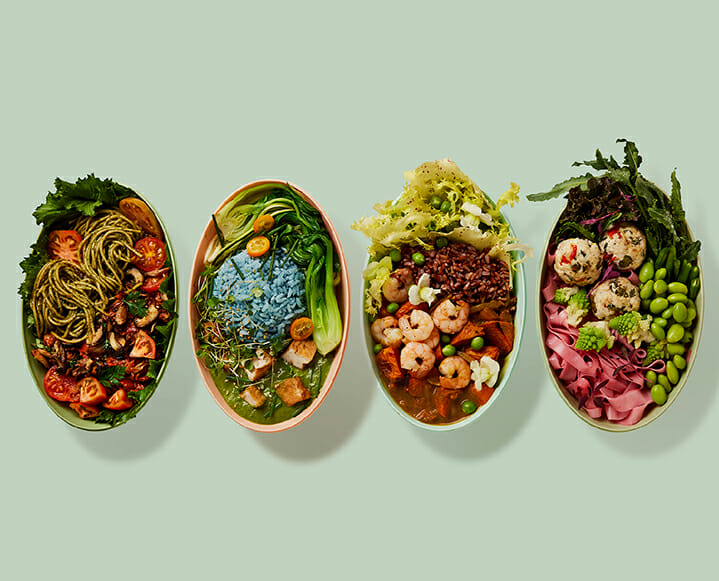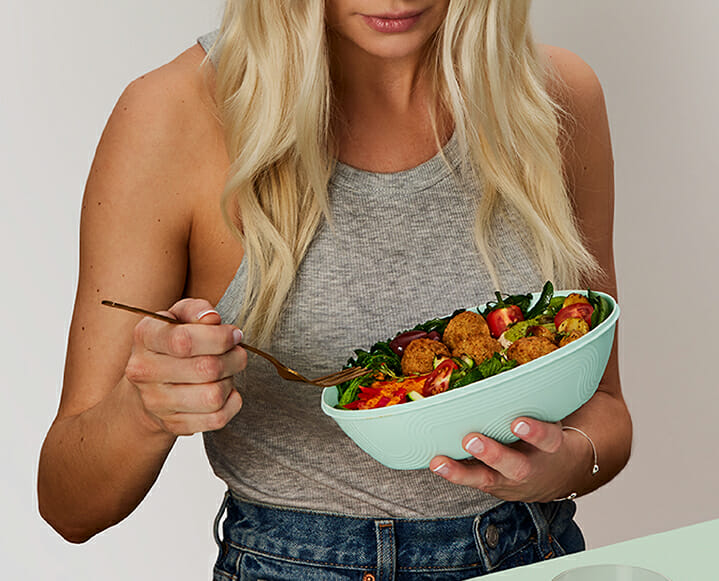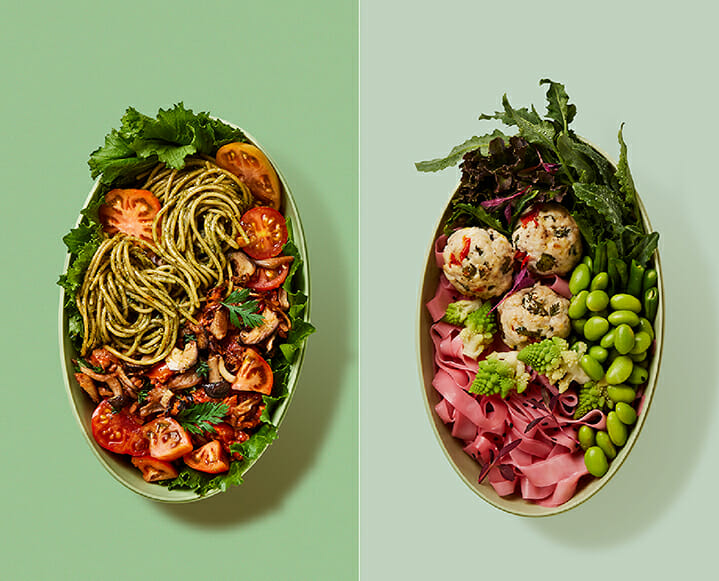When it comes to nutrition, the wellness scene has splintered in many directions lately — whether plant-based, oxalate-free, paleo or carnivorous. After all, there is no ‘one size fits all’ diet, and a bit of diversity in these fast-paced wellness trends can be a good thing!
Julie Nguyen is the founder and CEO of Methodology, and knows the value of a diverse diet better than anyone. Methodology offers a high-end meal prep service for busy professionals who want “fine dining-quality, nourishing, delicious meals”. (Read: a clean, affordable alternative to addictive services like Doordash or Postmates).
Since her meal prep service offers such a wide array of dietary preferences, we sat down with Julie to ask her about what nutrition trends she’s seeing now and how people are eating today specifically…
What Wellness Looks Like Now According To Julie Nguyen of Methodology
My own ‘aha moment’ with nutrition: I felt motivated to change my eating habits for good once I realized that my nutrition affected not only my weight but also my overall health and happiness. It was life-changing to move off all my prescription drugs, not have to carry an inhaler around anymore, clear my acne and eczema, and feel optimistic and energized like I was a teenager again.
3 Nutrition Trends You’re Loving Now: 01 Maximizing plant variety in order to optimize gut health
02 The move away from large intermittent fasting windows and instead toward getting optimal protein every day
03 Training women to eat intuitively and in line with their monthly hormonal changes.
 Nutrition Trend You’re Ready To See Go: All of the vegan fake meats made with tons of processed ingredients. Though the creators were well-intentioned, I predicted from the beginning that this would be another “margarine” that we’d eventually drop in favor of eating whole foods from nature rather than food made in labs.
Nutrition Trend You’re Ready To See Go: All of the vegan fake meats made with tons of processed ingredients. Though the creators were well-intentioned, I predicted from the beginning that this would be another “margarine” that we’d eventually drop in favor of eating whole foods from nature rather than food made in labs.
Your favorite Methodology dish this season: Our seasonal adaptogenic Relaxation Pumpkin Bread that sells out every Thanksgiving.
What changes have you seen in the way people eat this year? More carnivores? More vegans? There’s so much good science emerging on both diets! We aren’t seeing more carnivores or vegans, but we are seeing more people lean toward the Mediterranean diet as they’ve realized it’s the most science-backed diet. We are clinically validated by Stanford University for our Mediterranean diet-inspired menu that is gut health-friendly and very easy to stick with long-term because it isn’t highly restrictive.
What have you learned about how people really eat from inside your business? We have been around long enough that we’ve seen nutrition trends come and go. When we first started, paleo and Whole30 were all the rage. Then there was a slight rise in demand for vegan. Now people seem to be moving away from vegan and deciding that they are happy to cut back on meat and seafood a bit, but still prefer it in most meals, especially if it’s from a sustainable source.
Plus, with the increased interest in gut health, there’s also more interest in getting enough fiber. And one thing has been consistent throughout: demand for high protein meals, which I feel glad about because it is important to get not just adequate protein every day but optimal levels. Protein is also incredibly satiating, which makes it great for weight loss.
You talk about working with a naturopathic doctor to determine your health needs. Can you talk about learning your personal needs rather than eating a diet that’s trending? I learned from personal experience and have observed from feeding over 125,000 customers over 8 years that when it comes to food sensitivities, everyone is completely different, and avoiding food sensitivities can alleviate or heal auto-immune health issues and even mental health.
For example, I’m highly allergic to wheat and dairy, even when I eat the highest quality versions of these foods in places like Sardinia, Italy, one of the world’s Blue Zones. These foods trigger acne, eczema, and asthma in me.
Also, an individual’s food sensitivities can change over time as they repair their gut and overall health. When I first started testing my food sensitivities, dozens of foods triggered health issues for me, including very common everyday foods like chicken, cashews, and coconut. Now I’m down to only having sensitivities to wheat and dairy. Healing your gut takes time, but it’s worth it to be able to eat a wider variety of food. I believe everyone should eat the least restrictive diet they possibly can while still optimizing their overall health.
 What have you learned about ingredient sourcing that you wish more consumers knew? Working in the food industry helped me understand why processed, long shelf-life food is so inexpensive and also so bad for us. Two huge things shocked me about ingredient sourcing that I wish more consumers knew…
What have you learned about ingredient sourcing that you wish more consumers knew? Working in the food industry helped me understand why processed, long shelf-life food is so inexpensive and also so bad for us. Two huge things shocked me about ingredient sourcing that I wish more consumers knew…
First, packaged foods don’t have to list all of the ingredients used, so there are “organic” products out there that include ingredients such as flavor maskers you will never see on an ingredient list. This is why I recommend avoiding most foods with long shelf lives because you never know what you’re truly eating. The longer the shelf-life, the more likely hidden ingredients have been used to preserve the flavor, look, smell, and texture of the food.
Second, avoid anything that lists “natural ingredients” on the label as this is where companies will lump in ingredients that would and should sound scary if they were listed on the label. Again, these are ingredients used to improve the flavor, look, smell, shelf-life, and texture of food.
Methodology is ‘clinically validated’. What did you learn about meal planning or nutrition in that process that would interest readers? Going through clinical validation was eye-opening for me.
First, I never realized how difficult it is to do a nutrition study if participants aren’t being given the exact food they’re supposed to eat. People are busy, diets are hard to stick with, and life gets in the way, so the typical nutrition study can’t be very confident that people are eating what they say they’re eating, unless it was conducted somewhere like a prison or campus dining hall. This inability to feed participants in most nutrition studies makes the data from them less reliable, and this is also why the study we did with Stanford University was so great. We knew exactly what everyone was eating because they were eating Methodology.
Second, the outcome of the study was fascinating. We put the highest quality keto diet against the highest quality Mediterranean diet and learned that participants could eat whole food carbohydrates from things like fruit, whole grains, and legumes and still lose as much weight and equally improve the markers of diabetes. Plus, those on the Mediterranean diet stuck with it more consistently. I hope to see more studies like this that help people realize that we don’t need to avoid all carbs to achieve our health goals, we just need to cut back on refined carbs.
When you’re not eating Methodology, what are you usually cooking at home? I cook very healthfully when I’m at home and prefer eating Asian food. My favorite very fast, go-to meal to make at home is fried cauliflower rice. I usually make it using whatever produce I have on hand, but in its most ideal form, I stirfry shiitake mushrooms, asparagus, cauliflower rice, porcini powder, onion powder, pink salt, fish sauce, egg whites, and a can of wild sardines in EVOO. Then I top it off with Thai basil, lime juice, and broccoli sprouts. It sounds a bit insane, but it tastes amazing because of how the EVOO soaks up the umami from the sardines. Plus, it’s extremely high in protein, fiber, and omega-3. This is inspired by Vietnamese salted fish fried rice, something I grew up eating. I altered the recipe to be much lower calorie, higher protein, higher fiber, and veg-packed. This is basically what we do at Methodology—take everyday household favorites and transform them into their most nourishing versions.
You want people to consider your service in lieu of Doordash or Postmates. What’s the comp there roughly? If you were to recreate a Methodology meal on DoorDash or Postmates, you’d need to order a protein main and two veggie sides or appetizers, at the minimum. Doing this would result in a meal, with all taxes and fees, that would cost at least $25-35. Plus, you wouldn’t know what ingredients were used, and it’s highly likely the protein was not sustainable (wild seafood or pastured protein) and that the meal included inflammatory oils or refined sugar.
 Any other great tips for convenient healthy meals at home when people aren’t using your service? For convenient healthy meals at home when not using Methodology, I recommend learning how to assemble meals quickly using prepped vegetables, sustainable protein (wild seafood and pastured protein), and whole food carbohydrates (rice, potatoes, oats) from Trader Joe’s. There are a few basic keys to making food tasty at home. First, don’t overcook the protein. Most should be cooked using medium heat on the pan, not high heat. Also, protein continues to cook after it’s removed from the heat, which is where most amateur home chefs go wrong. Second, have fun trying different delicious spice mixes until you uncover your favorites.
Any other great tips for convenient healthy meals at home when people aren’t using your service? For convenient healthy meals at home when not using Methodology, I recommend learning how to assemble meals quickly using prepped vegetables, sustainable protein (wild seafood and pastured protein), and whole food carbohydrates (rice, potatoes, oats) from Trader Joe’s. There are a few basic keys to making food tasty at home. First, don’t overcook the protein. Most should be cooked using medium heat on the pan, not high heat. Also, protein continues to cook after it’s removed from the heat, which is where most amateur home chefs go wrong. Second, have fun trying different delicious spice mixes until you uncover your favorites.



